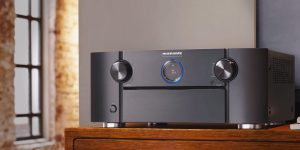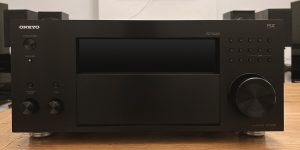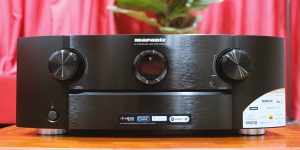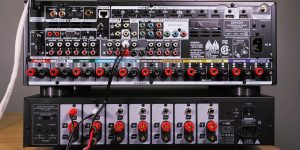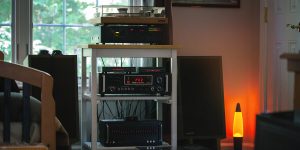As you probably already know, with their warm, rich sound, vinyl records are back in vogue. Millions of people worldwide are buying vinyl records again or pulling out of the attic devices that belonged to their parents. To fully enjoy the vinyl, AV receivers with built-in phono input have become sought-after components in home audio setups. Its inclusion in AVRs eliminates the need for external phono preamps, simplifying the setup process. That’s why, for this review, I chose the best receivers for turntables, where I prepared and tested the most interesting models for you.
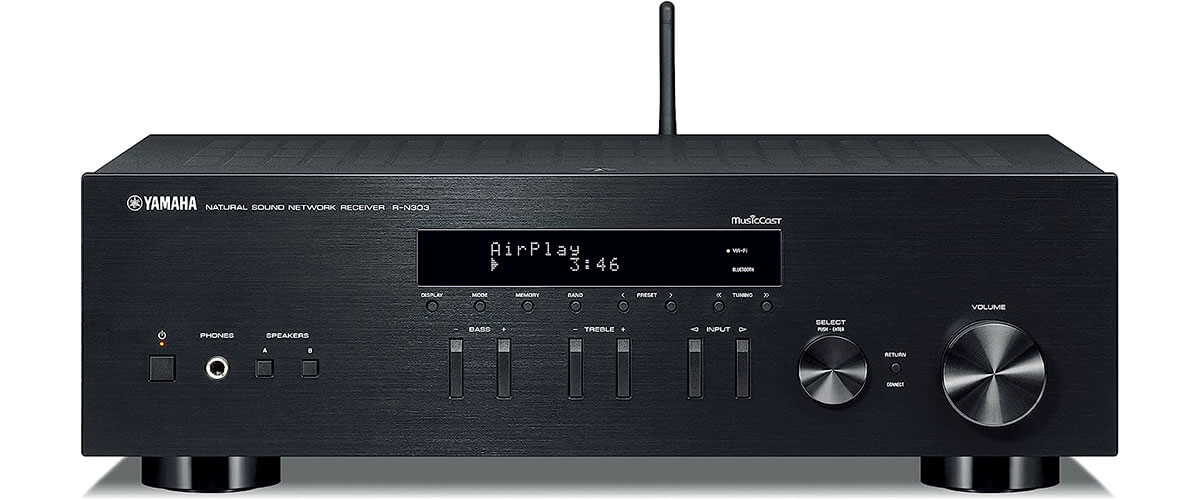
Stereo receivers for turntables comparison table
| Name | Channels | Power output | HDMI in/out | Bluetooth/Wi-Fi | Review |
|---|---|---|---|---|---|
| Yamaha R-N303 best stereo receiver | 2.0 | 140W/8 Ohm, 115W/4 Ohm | has not | yes/yes | Review |
| Sony STRDH190 | 2.0 | 100W/8 Ohm | has not | yes/no | Review |
| Denon DRA-800H | 2.2 | 100W/8 Ohm, 120W/6 Ohm | 5/1 | yes/yes | Review |
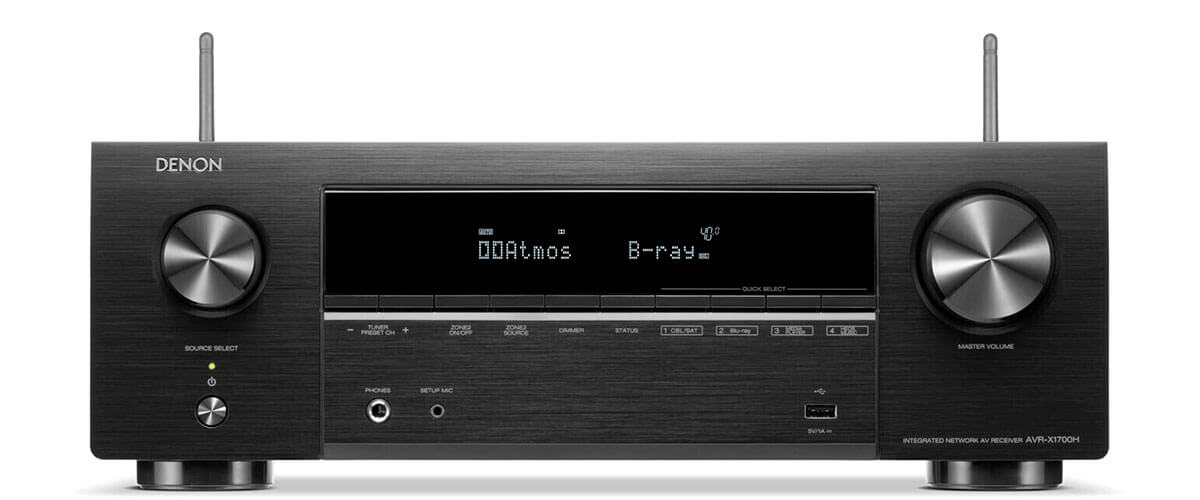
AV receivers for turntables comparison table
| Name | Channels | Power output | HDMI in/out | Bluetooth/Wi-Fi | Review |
|---|---|---|---|---|---|
| Denon AVR-X1700H top-rated AV receiver | 7.2 | 80W/8 Ohm, 175W/6 Ohm | 6/1 | yes/yes | Review |
| Yamaha RX-V6A | 7.2 | 100W/8 Ohm | 7/1 | yes/yes | Review |
Stereo vs AV receiver for record players

If your primary focus is on music and you want to optimize the audio quality from your record player, a stereo receiver can be an excellent choice. AV receivers are designed to handle both audio and video signals. While they offer good audio performance, stereo receivers often provide music fans with a more specialized and refined sound experience.
Specifically built for two-channel audio, stereo receivers are ideal for a traditional stereo setup commonly used for vinyl records. AVRs are designed for multi-channel audio setups, typically starting from 5.1 channels and going up to more advanced configurations. An AV receiver might be more suitable if you plan to build a home theater system with surround sound.
Key features to consider when choosing a turntable receiver
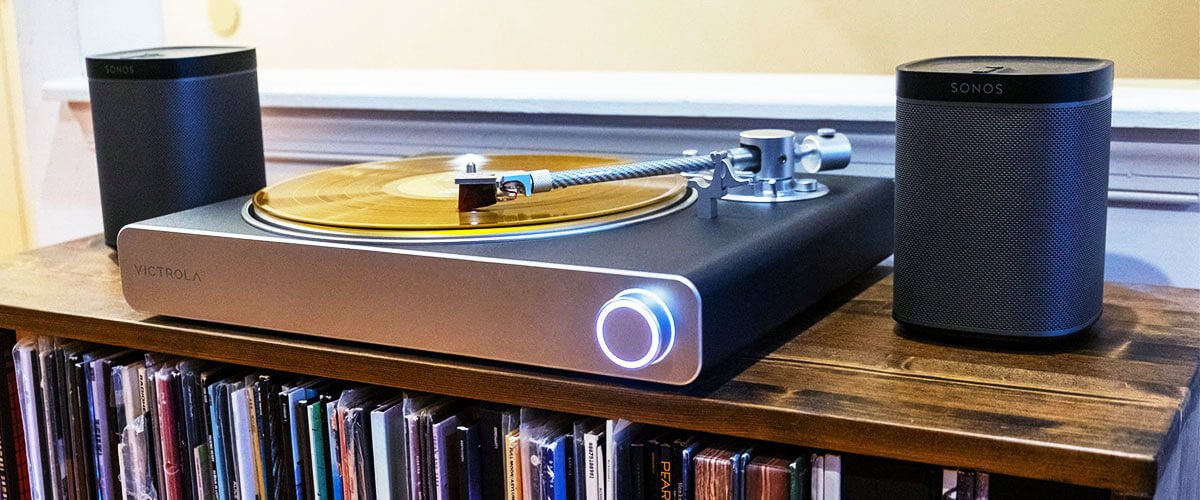
Power and impedance ratings
First of all, remember these basic rules. The average power rating for AV receivers is 50-80 Watts (I’m not talking about advanced configurations like 7.2 or more). The best AV receiver for a record player shouldn’t have the highest power rating. I can tell you that it doesn’t guarantee you the greatest sound out there. In addition to the power rating, pay attention to the THD specification. Lower THD values (under 1%) indicate cleaner and more accurate sound reproduction. The lower the value, the better.
The impedance rating of the equipment should also match the nominal impedance of your speakers. Common speaker impedance ratings include 4, 6, and 8 ohms. Ensure that the receiver’s impedance output is within the range supported by your speakers. Most devices are designed to work with speakers within the 6-8 ohm range. If the impedance mismatches, you risk wear and tear on the equipment.
Phono input
A dedicated phono input is required for connecting a turntable to the receiver. This input includes a built-in phono preamplifier (phono stage) that amplifies the low-level signal produced by the turntable’s cartridge. Some turntables have a built-in phono preamp, and in such cases, you might prefer a receiver with a phono preamp bypass feature. This allows you to use either the built-in preamp or an external one, offering flexibility based on your turntable’s configuration. Don’t forget to check whether the receiver is compatible with the type of cartridge on your turntable. Some cartridges may have specific impedance or output level requirements that the unit should accommodate.
Connectivity options: Bluetooth, Wi-Fi, etc.

It’s useful when the receiver for the record player has enough input options to handle other audio sources you might want to connect, such as CD players, streaming devices, or other devices.
Most modern receivers have Wi-Fi and Bluetooth connectivity. Wi-Fi enables features such as firmware updates, online streaming services, and networked audio playback. Bluetooth capability allows you to stream audio from compatible devices to your equipment wirelessly. This feature is convenient for playing music or podcasts without physically connecting devices.
For owners of Apple devices (which is the vast majority of users), it would be useful to have built-in AirPlay (as well as Chromecast for Google devices) to stream audio wirelessly within a longer range compared to Bluetooth (which is up to 30 feet or so).
AVRs also support popular streaming services directly and come with built-in apps for Spotify, Tidal, Pandora, or others, allowing streaming without additional devices.
In case you want to create a multi-room setup with compatible speakers, there are units with their own multi-room audio systems, such as HEOS by Denon or MusicCast by Yamaha.
Best receivers for turntables
Stereo receivers
Yamaha R-N303 – best stereo receiver

My rating starts with the Yamaha R-N303 – a universal stereo receiver with a phono input, which organically combines classic design and modern functionality. It has a solid output power of 100 W (8 Ohm, 40 Hz-20 kHz, 0.2% THD). If you want a good sound in a small to medium space, it’s perfect.
The R-N303 includes various digital inputs, such as optical and coaxial, offering versatility in connecting to a range of digital audio sources. It also features analog inputs for traditional components. Of course, there is for what many of you are here today – a dedicated phono input with a built-in phono preamp. This allows you to connect your turntable directly to the unit.
In case you’d like to switch to an advanced music experience, you can use a built-in Bluetooth connectivity or Wi-Fi option to wirelessly stream music from your compatible devices. However, if consistent, free-of-drop-out Bluetooth performance is a priority, I would note this issue sometimes happens with this model.
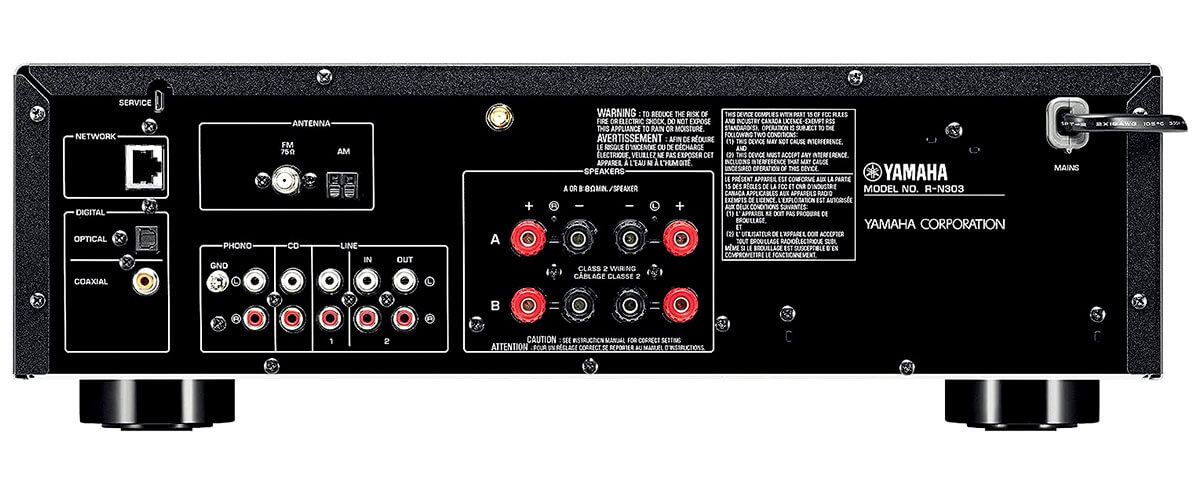
Yamaha’s MusicCast technology is integrated into the R-N303, enabling multi-room audio and seamless integration with other MusicCast-compatible devices. This feature enhances your flexibility in creating a whole-home audio system.
Moreover, it has YPAO, which analyzes the acoustics of your room and adjusts various audio parameters to optimize sound quality. This feature contributes to a more balanced and tailored audio experience based on your listening environment.
For testing, I played the “Bob Marley & The Wailers – Legend” record, where the warmth, depth, and clarity of the music are truly captivating. The sound was clear and had the necessary clarity. I was especially pleased with the playback of the song “Get Up Stand Up”. All nuances were heard, and accents were correctly placed. It was just a magic balm for my ears! I was surprised with the lack of a balance control on the front, although the balance can still be adjusted from the setup menu. In my opinion, Yamaha has improved the sound quality in this model over its predecessors – especially in the stereo separation and clarity aspects of digital sources.
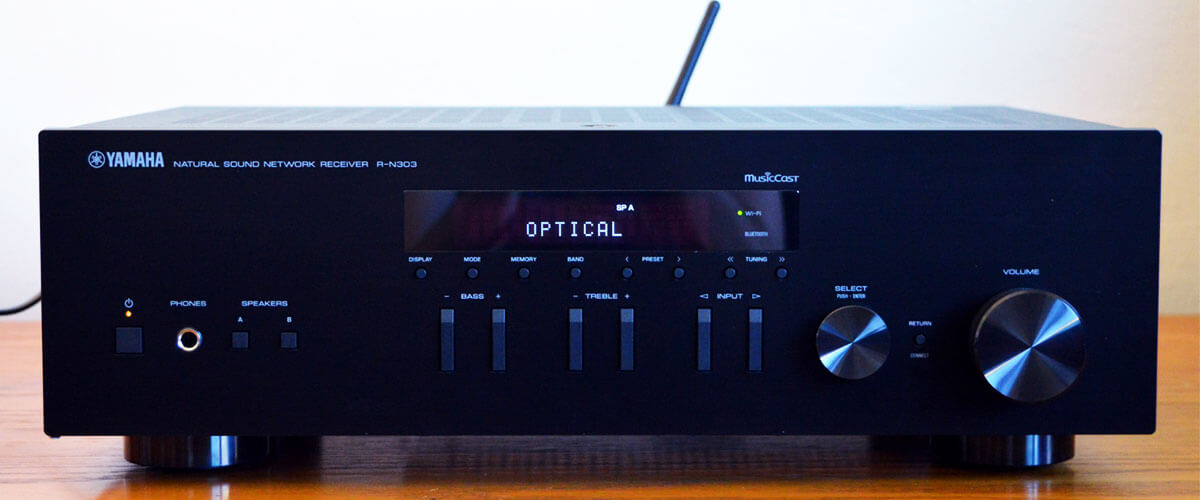
It’s hard to argue about the Yamaha R-N303 when it relates to awesome sound performance, so you won’t be disappointed. If you’re looking for the best stereo receiver for a turntable with networking capabilities as a bonus, this is a great option without breaking the bank.
Key specs
- Channels: 2.0.
- Power output: 140W/8 Ohm, 115W/4 Ohm.
- HDMI inputs/outputs: has not.
- Video functions: has not.
- Bluetooth/Wi-Fi: yes/yes.
- Streaming services: Spotify, TIDAL, Deezer, Napster.
- Surround sound: has not.
Pros
- Versatile in terms of source connections.
- Ensures great sound with Yamaha’s characteristic warm tones.
- Advanced networking capabilities.
Cons
- The Bluetooth signal isn’t consistent.
- Lacks balance control on the front.
Sony STRDH190 – budget stereo receiver
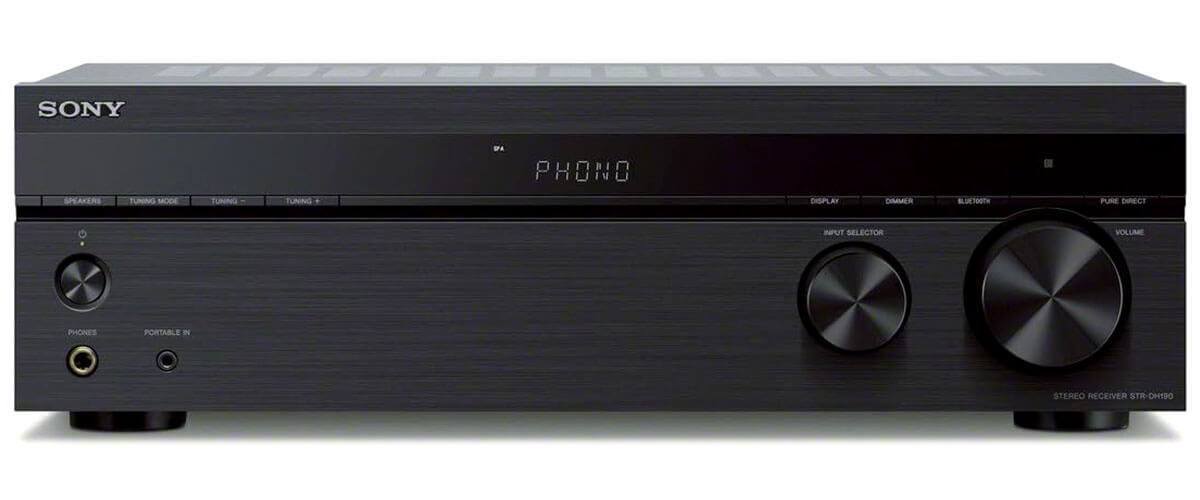
In my reviews, I try to select devices of different levels (budget, mid-range, and premium), so as one of the most suitable budget receivers for a turntable, I’ve chosen the Sony STRDH190. This model is more likely aimed at avid minimalists or those for whom networking capabilities are not important in such a device (since no Wi-Fi option is provided). The STRDH190 provides 90W at 8 Ohms, 20-20.000 Hz, 0.09% THD. By the way, the device is quite versatile and can work with various speaker systems (from 6 to 16 ohms), providing a powerful enough sound.
It features multiple analog audio inputs, a dedicated turntable phono input, and 4 RCA inputs for a versatile setup. By the way, the phono preamp and transformer are optimally designed to minimize disturbances in the magnetic field.
One of the useful features, like the A/B speaker switching, allows you to connect and switch between two sets of speakers. You might have two sets of speakers with different characteristics or for different purposes, so you can choose the speakers that suit your current audio needs.
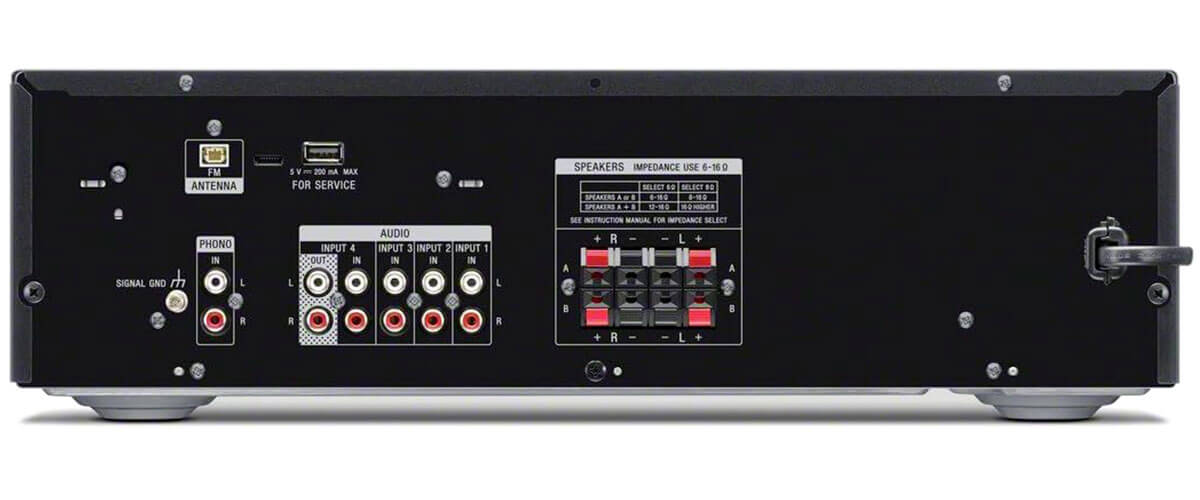
The only option to stream music wirelessly is built-in Bluetooth technology. Playing a couple of times through it, I noticed periodic sound distortion during Bluetooth play. The phono sound is still very good. When I first turned the unit on, the Bluetooth sound was clear and unaffected, but as time went on and the amp heated up, the quality dropped significantly.
Sony STRDH190 was tested with my beloved Jimi Hendrix. The vinyl sounds amazing, even when paired with some old bookshelf speakers. Hendrix’s soulful vocals and groundbreaking guitar work in “All Along the Watchtower” really surprised me with the sound quality of this unit. It produced a crisp and clean enough sound, like some expensive systems. I’d say STRDH190 can increase the fidelity of the vinyl records if your MM-type cartridge is not top-of-the-line. I have only one complaint, and that is the volume encoder. It is not of high quality, and it takes quite a bit of force to turn it. My last advice would be not to lose the remote, as it provides 90% of the functions for this unit!
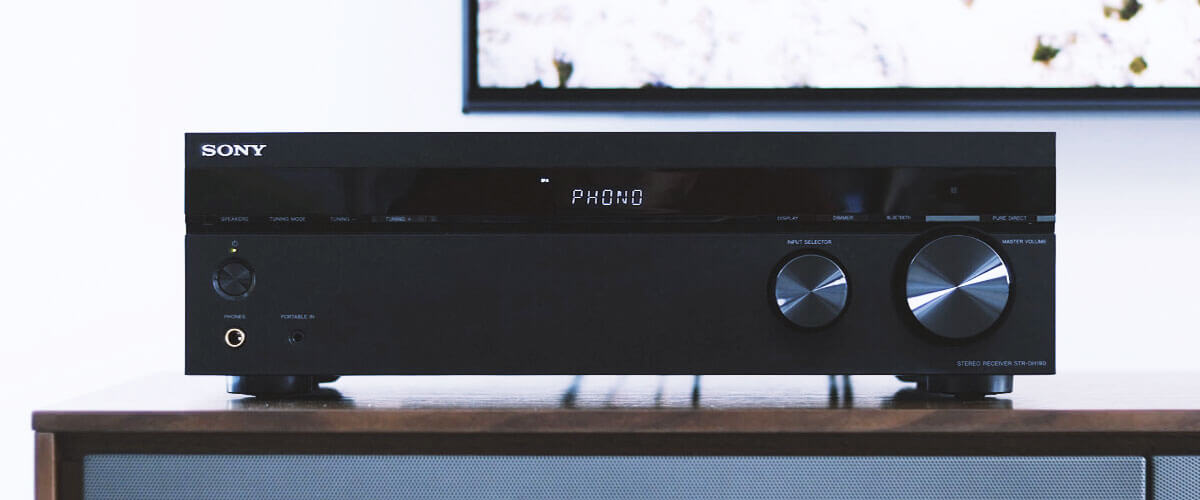
If you choose to sit back and enjoy your music collection, this little Sony is an affordable, quality choice. The vinyl definitely sounds far more pleasantly rather than without it. It’s not a power monster, but with the right speaker match, you get a very nice piece of audio equipment at the right price point.
Key specs
- Channels: 2.0.
- Power output: 100W/8 Ohm.
- HDMI inputs/outputs: has not.
- Video functions: has not.
- Bluetooth/Wi-Fi: yes/no.
- Streaming services: has not.
- Surround sound: has not.
Pros
- Handles from 6 to 16 Ohms speakers.
- Phono preamp is optimally designed to minimize disturbances in the magnetic field.
- Allows A/B speaker switching.
Cons
- No Wi-Fi option.
- Bluetooth signal drops at times (especially when the amplifier is heated).
Denon DRA-800H
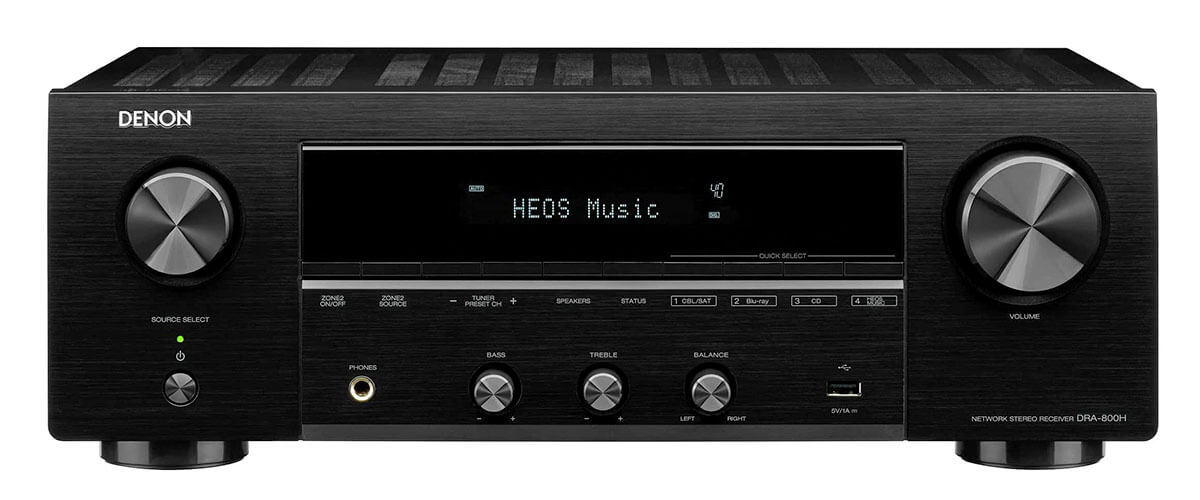
Denon DRA-800H is in many ways superior to the previously described Sony STRDH190 and Yamaha R-N303. This stereo receiver with turntable input combines high-quality audio performance with modern connectivity options. It has a powerful Class D amplifier that delivers 100W at 8 Ohms, 20 Hz – 20 kHz, 0.08% THD. Here, you have options for various audio formats, including FLAC, ALAC, and WAV up to 24-bit/192kHz.
What makes it stand out is that the unit features 5 HDMI inputs, allowing you to connect external audio and video sources, such as gaming consoles or Blu-ray players. HDMI ARC support simplifies the connection to compatible TVs. Moreover, there’s support for 4K video resolution and HDR10.
The inclusion of Bluetooth and Wi-Fi connectivity seamless wireless audio playback. With built-in HEOS technology, the amplifier provides versatile networking capabilities. It supports popular streaming services, including Spotify, Pandora, Tidal, and more.
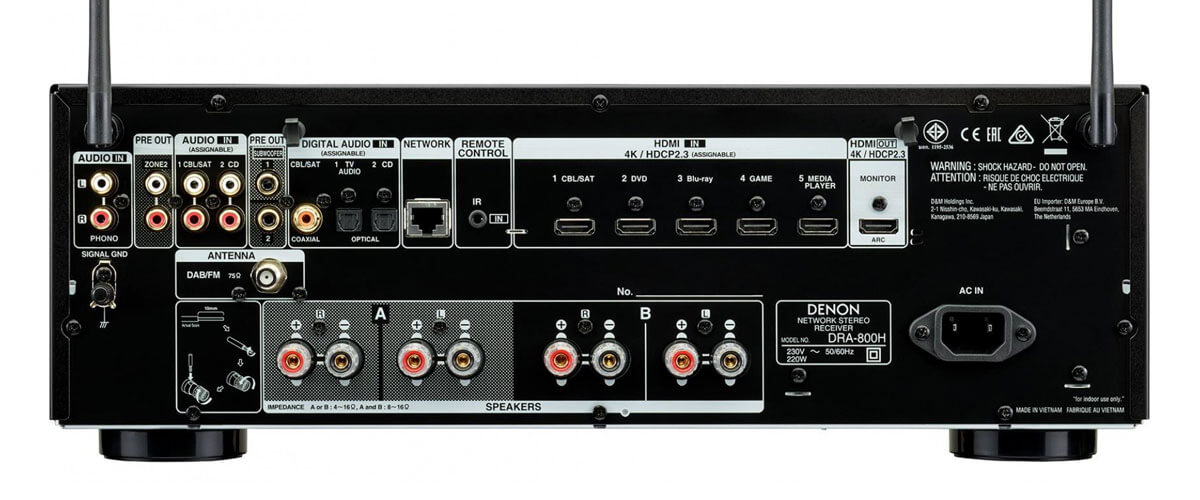
The presence of Zone 2 pre-outs allows for audio playback in a second zone, providing flexibility for creating different audio environments in various rooms. So, as you can see, you can do plenty of things with the DRA-800H and Denon AVR Remote app that simplifies the operation, allowing you to manage settings and playback from your mobile devices.
However, I have had a few glitches. Sometimes, the device requires a restart to switch sources. The next time, I was required to restart it to change the eco-mode and initiate setup.
This time, I chose something more crazy for the test. My wife is not as enthusiastic about the Black Sabbath as I am. Nevertheless, I put on “Paranoid” and played it pretty loud. Although she doesn’t like loud music, she sat still through the whole tune and then said, “Wow!”.
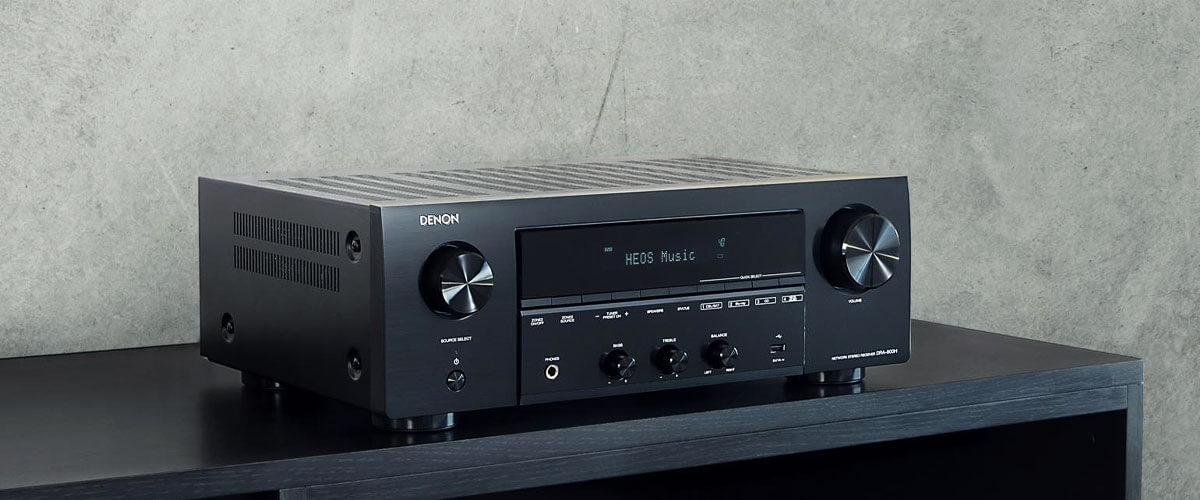
DRA-800H produced a much cleaner, tighter sound with more detail of the iconic guitar riff played by Tony Iommi. The music sounds good; however, the quality of the recording plays a significant role in the final result you get with this equipment. It had an excellent mid-spread with a great low-end punch, even when I turned the subs off. The phono stage was clear, and I enjoyed the vinyl record sound through headphones listening to the forceful and filled with raw energy vocals of Ozzy Osbourne. The balanced bass is especially important for this song’s bassline, adding depth and weight to the musical arrangement.
If you like the features of the Yamaha but want something with a “warmer” sound, then the Denon DRA-800H is the right choice to go. Since it combines good amplification, modern connectivity, and a range of features, this model caters to both traditional and contemporary audio preferences.
Key specs
- Channels: 2.2.
- Power output: 100W/8 Ohm, 120W/6 Ohm.
- HDMI inputs/outputs: 5/1.
- Video functions: 4K/60Hz.
- Bluetooth/Wi-Fi: yes/yes.
- Streaming services: Airplay 2, Pandora, Spotify, Napster, SiriusXM, TIDAL, Deezer, Qobuz, Amazon Music.
- Supports: HDR, HLG.
- Surround sound: has not.
Pros
- Includes 5 HDMI inputs.
- Offers Zone 2 feature for multiroom audio experience.
- Provides really high-quality sound.
- Supports 4K and HDR10.
Cons
- I had a couple of glitches that required a restart.
AV receivers
Denon AVR-X1700H -best AV receiver

If you prefer more complex equipment and don’t mind spending hours setting it up, then the next AVR should be considered. Denon AVR-X1700H offers an immersive sound experience with 7.2 channels, delivering 80W at 8 Ohms, 20Hz – 20kHz, 0.08% THD. It supports the latest three-dimensional audio formats like Dolby Atmos and DTS:X. In this model, the output impedance of the DAC is reduced for an optimal damping factor.
HDMI connectivity is a standard feature for this category. This includes 6 HDMI inputs and 1 output with support for 4K Ultra HD, HDR, and HDCP 2.3, allowing you to connect various media devices, gaming consoles, and 4K displays.
Of course, there’s network connectivity, enabling streaming from popular services like Spotify, Pandora, Tidal, and others. Built-in Wi-Fi and Bluetooth support enhance wireless streaming capabilities. AVR-X1700H can be operated hands-free with one of the popular voice control platforms, such as Amazon Alexa, Google Assistant, or Apple Siri.
Multi-room audio capabilities are integrated with Denon’s HEOS technology, allowing you to create a whole-home audio system. This enables streaming music to different rooms from various sources. By the way, the music streamed via HEOS was much cleaner and more expressive than via Bluetooth. Zone 2 feature is also available, but there are no options to adjust tone settings for it. So, let’s say you can count on Zone 2 sounding like elevator music.
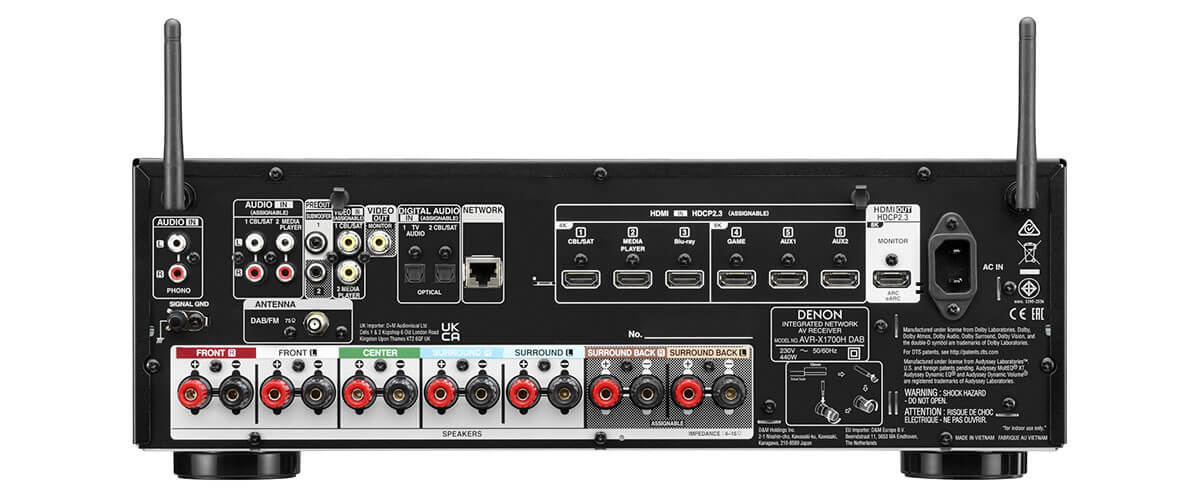
In order to make the whole process using AVR-X1700H easier, you should use Audyssey MultEQ room calibration technology, which helps optimize the audio performance based on the acoustic characteristics of your listening environment. It’s especially handy since the lack of a paper manual for this model is a bit frustrating.
Another thing that concerned me is the user interface, which, in my opinion, is kind of outdated and not totally user-friendly. Agree that the most important thing about AV receivers is sound quality, but having UI from the mid-90s today is slightly ridiculous.
While I was enjoying the surreal lyrics and captivating musical arrangement of “White Rabbit” by Jefferson Airplane, I noticed how fully-bodied the music was. The powerful and charismatic vocals couldn’t be greater. The quality of the repetitive and hypnotic guitar riff blew me away. The receiver played well for its level. But I didn’t really like the built-in receiver phono stage. It’s more efficient on my record player, in my opinion. Even though I managed to hear all the nuances of this song (maybe because it’s one of my favorites), the volume up/down has an annoying delay. I found myself frustrated not changing in real-time, resulting in volume going higher than I wanted and then overcompensating, trying to turn it down after it reached its peak.
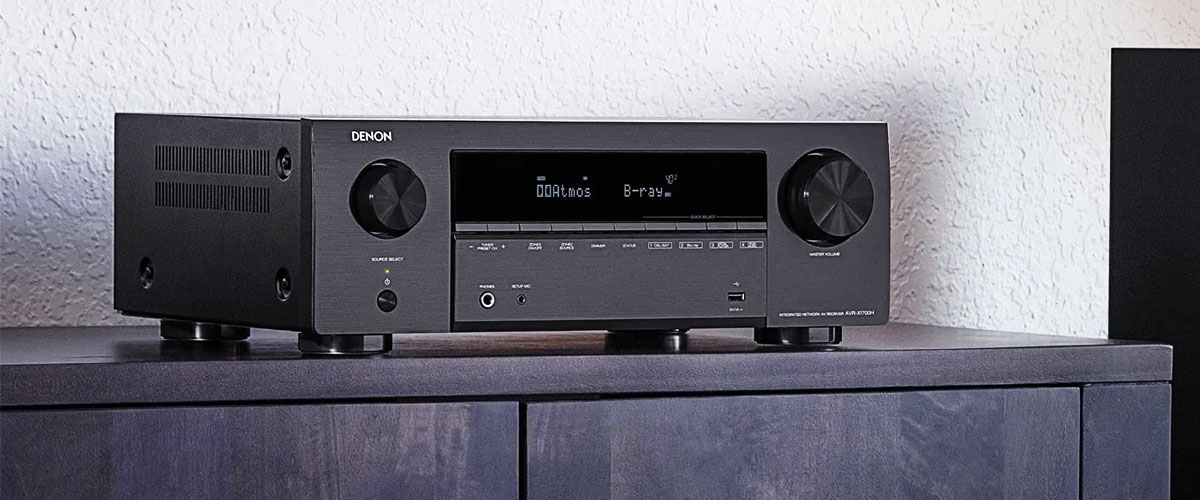
In general, if you need quality equipment not only for listening to music but also for the ability to watch movies, I would definitely recommend the Denon AVR-X1700H. It is easy to set up, will delight music lovers with excellent sound quality, and its features will create a complete home theater in your living room.
Key specs
- Channels: 7.2.
- Power output: 80W/8 Ohm, 175W/6 Ohm.
- HDMI inputs/outputs: 6/1.
- Video functions: 8K/60Hz, 4K/120Hz, upscaling to 8K.
- Bluetooth/Wi-Fi: yes/yes.
- Streaming services: AirPlay 2, Spotify Connect, Tidal, Deezer, Amazon Prime Music, Pandora.
- Suppots: HDMI eARC, HDMI ARC, HDMI CEC, Dolby Vision, HDR 10+, Dynamic HDR, HLG.
- Surround sound: Audyssey, DTS HD Master, DTS:X, DTS Neural:X, DTS Virtual:X, Dolby TrueHD, Dolby Atmos, Dolby Atmos Height Virtualization, Dolby Atmos Music, Dolby Surround, Multichannel Stereo.
Pros
- Streamed music via HEOS was much cleaner and more expressive.
- Reduced output impedance of the DAC for an optimal damping factor.
- Organically combines the capabilities of a stereo receiver and a full-fledged AVR.
Cons
- No options to adjust tone settings for Zone 2.
- No paper manual included.
- Delayed volume up/down.
Yamaha RX-V6A – budget AVR
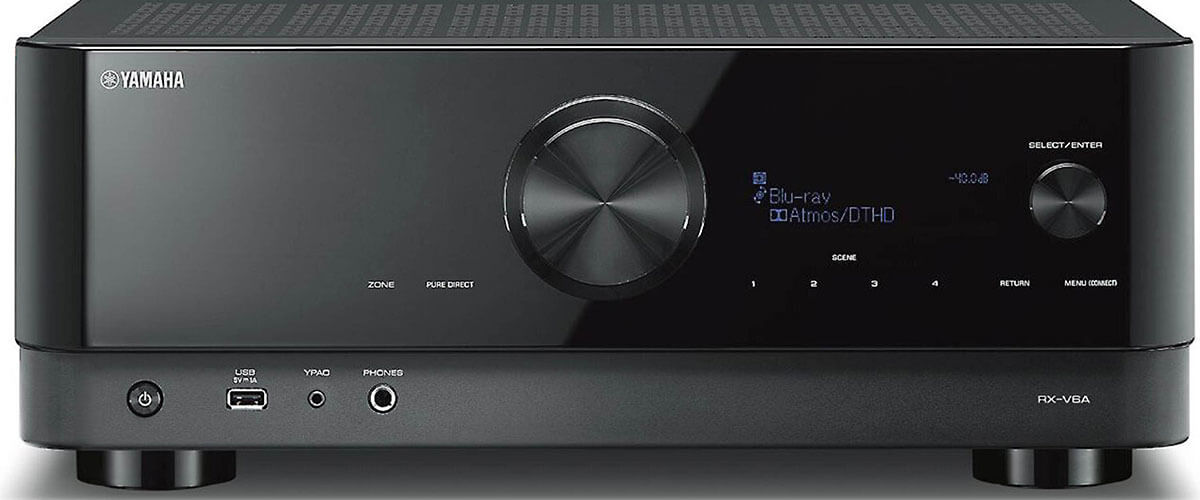
Among AVR models, the Yamaha RX-V6A is a good receiver for turntable and one of the budget options to choose from. It offers up to nine possible configurations ranging from simple stereo to 5.1.2 and a 7.1 installation, delivering 100W (8 Ohms, 20Hz-20kHz, 0.06% THD).
A few words I’d say about the design. The receiver’s display is small, oddly placed, and hard to read. There is a minimum of convenience and information content in it. It’s a pity. But you can see how the sound flows through the channels or what the current sound format and volume are. And those who can be easily annoyed by fingerprints on its glossy front make a note.
What you might like about this receiver are 17 DSP programs that equip the RX‑V6A, which are used by Yamaha’s most high-end equipment. It generates a signal resulting from a mixing of the different channels to offer a sensation of sound immersion. Dolby Atmos and DTS:X are also perfectly handled by the unit.
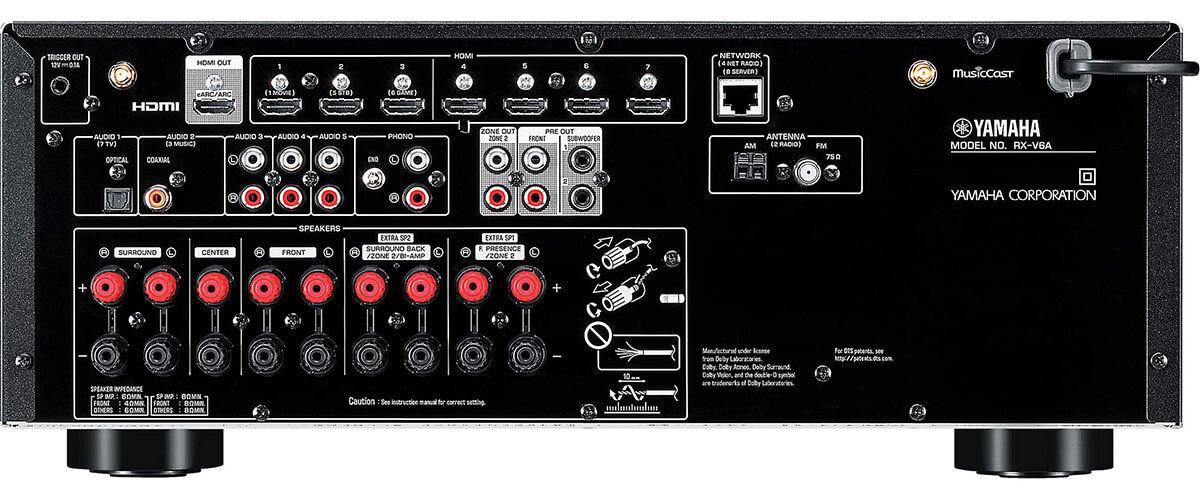
On the video side, the RX‑V6A is not limited to the source selection. It has 7 HDMI inputs, supporting 8K/60 Hz and 4K/120 Hz, along with an upscaling feature that normalizes all the videos to 4K Ultra HD format. However, HDMI ports, although version 2.1, have a bandwidth of only 24 Gbit (the standard itself allows up to 48 Gbit), which introduces compression at high resolutions. There is no HDMI connection in front for easy access (7 in the back and 1 in front would have been great). I read a lot of complaints regarding eArc functionality, but I have not noticed any of the widely reported sound dropouts using it. But switching over to the optical connection is easy if eARC is problematic for you.
The equipment has all network functionalities and is part of the brand’s MusicCast ecosystem. In addition to the traditional streaming playback offered by its DLNA and AirPlay 2 compatibility, it finds its place within a multiroom installation, both as a source and a broadcasting device. An integrated Wi‑Fi offers various streaming audio content services to choose from. You may also access content stored on a smartphone or tablet via built-in Bluetooth.
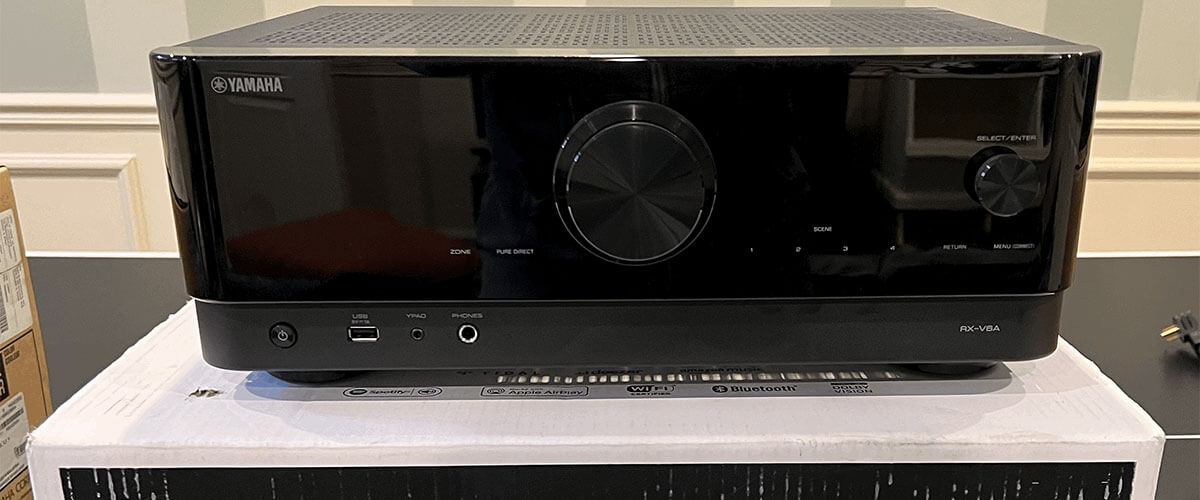
In order to test RX-V6A, I wanted some emotional delivery, and my choice fell on Billie Holiday. Yes, I can be unpredictable in music tastes. The record seemed brighter to me, but in a good way, with optimal sound quality in the higher ranges, especially when she was bending and stretching notes. I love the options Yamaha gives you for different sound modes, including theater and concert hall sound effects, which add a different feel when listening to music. Volume, detail of the piano, localization of tenor saxophone in space, and even dynamics of trumpet and trombone are all at the highest level. I even found myself backing it off in volume because of the “punch” it had during some parts of the double bass in the Holiday’s songs. Overall, the sound can be balanced, punchy, or bright to your taste and can produce brutal volume.
The Yamaha RX-V6A has plenty of options for different styles of listening and plenty of power, along with separation and clarity. In addition to the price point, such an AVR can greatly improve the sound of your record player.
Key specs
- Channels: 7.2.
- Power output: 100W/8 Ohm.
- HDMI inputs/outputs: 7/1.
- Video functions: 8K/60Hz, 4K/120Hz, 4K/60Hz.
- Bluetooth/Wi-Fi: yes/yes.
- Streaming services: Pandora, Spotify, Napster, SiriusXM, TIDAL, Deezer, Qobuz, Amazon Music.
- Supports: HDMI eARC, HDMI Upscaling up to 4k, HDMI CEC, HDCP2.3, HDR10+, Dolby Vision.
- Surround sound: Dolby TrueHD, Dolby Digital Plus, DTS:X, DTS-HD Master Audio.
Pros
- Includes 17 DSP programs for greater sound immersion.
- Delivers a balanced and punchy sound (sometimes even too much).
- Great video and connectivity specs (as for budget AVR).
Cons
- The display is small and hard to read.
- eArc might cause some issues (but I haven’t noticed any).

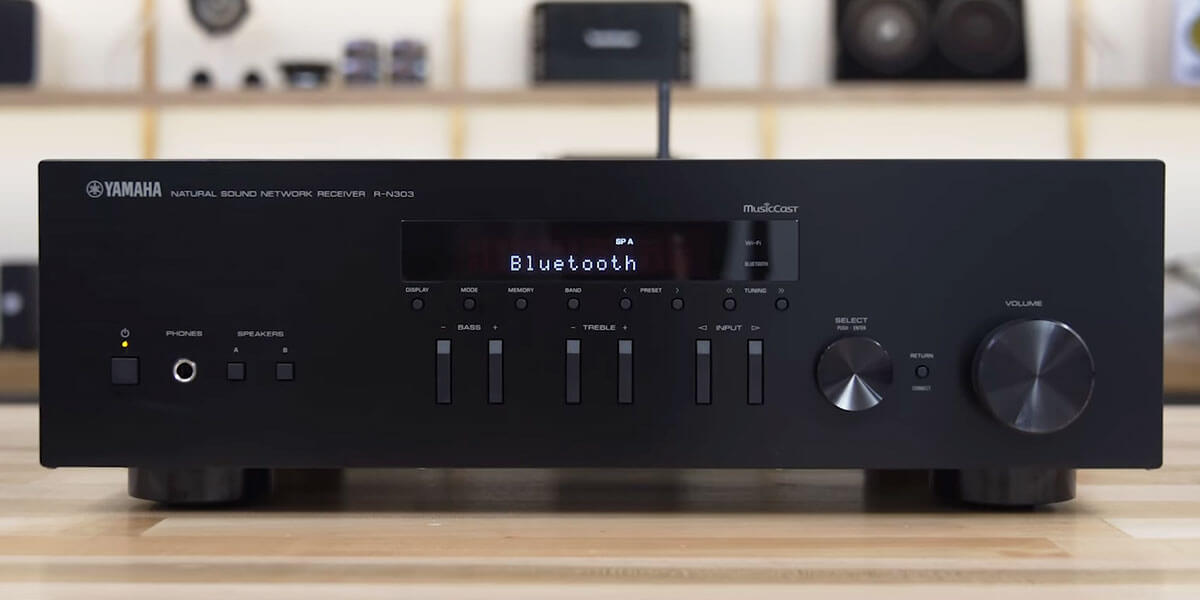

![Best 2-Channel Receiver [Expert Reviews and Buying Guide]](https://hometheaterology.com/wp-content/uploads/2023/11/best-2-channel-receiver-stereo-300x150.jpg)


